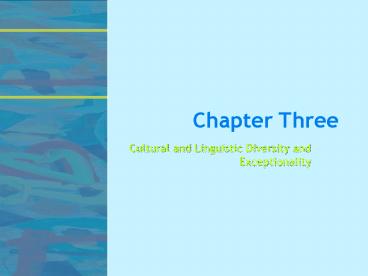Chapter Three - PowerPoint PPT Presentation
Title:
Chapter Three
Description:
Chapter Three Cultural and Linguistic Diversity and Exceptionality Terminology of Cultural Differences Culture Multiculturalism Multicultural education Bilingual ... – PowerPoint PPT presentation
Number of Views:67
Avg rating:3.0/5.0
Title: Chapter Three
1
Chapter Three
- Cultural and Linguistic Diversity and
Exceptionality
2
Terminology of Cultural Differences
- Culture
- Multiculturalism
- Multicultural education
- Bilingual education
- Describing diversity
- The federal government only recognizes five
distinct racial groups American Indian or
Alaskan Native, Asian or Pacific Islander,
Hispanic, Black, and White.
3
(No Transcript)
4
Insert insights feature pg 94
5
Disproportional Representation of Minority
Students in Special Education Programs
- Overrepresentation a situation in which greater
numbers of students of certain groups are placed
in special education than you would expect based
on their numbers in the school population - Underrespresentation fewer students in a
particular category than one might expect based
on their numbers in the school population
6
Disproportional Representation of Minority
Students in Special Education Programs
There is typically an overrepresentation of
minority students in special education
programs. There is typically an
underrepresentation of minority students in
gifted and talented programs.
7
Factors Contributing to Over- and
Underrepresentation
- Relationship between family socioeconomic status
(poverty) - Identification procedures by professionals from
culturally dominant backgrounds - Instructional methodologies reflect dominant
culture teachers - Dominant culture teachers perceptions of diverse
students learning needs
8
Consequences of Disproportional Representation
- May result in an inferior and less effective
educational experience - Increases risk for underachievement and school
dropout - May create limited employment opportunities
9
Assessment Innovations
- Nondiscriminatory assessments
- Test revisions
- Multiple Intelligences
- Portfolio assessments
- View the accompanying video to learn more about
Multiple Intelligences
10
Classroom Assessment Suggestions
- Assess a child in both English and in the native
language before administering other tests - A student must exhibit a disability when
evaluated in the native language - Schools should use multiple assessment tools
- Evaluators should use unbiased tools and
techniques - An interpreter may be used if bilingual education
is not available - Parents should be involved in developing
assessments
11
Educational Suggestions
- Display sensitivity to the cultural heritage of
all students - Use instructional strategies and materials that
respect different learning styles and personal
experiences - Consider the instructional environment and the
impact on student behavior - Watch this video to learn about
- Culturally Responsive Teaching































